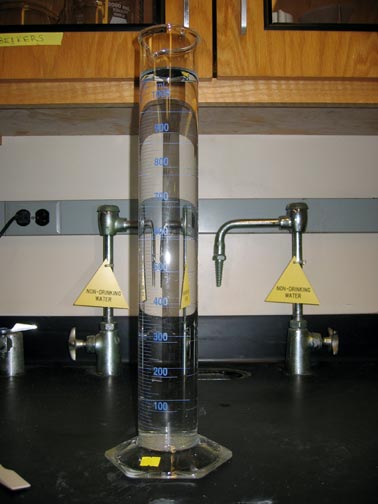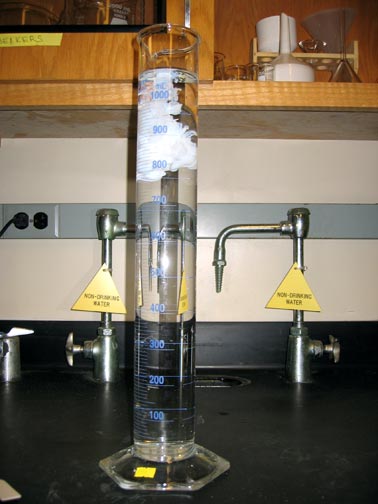Precipitation of silver chloride in solution
Drops of a colorless solution are added to a graduated cylinder of a still and colorless solution, creating a floating cloud of white precipitate and trails of "rain."


Ingredients: silver nitrate, sodium chloride, graduated cylinder
Procedure: A partial recipe follows.
1. Prepare a solution silver nitrate in a graduated cylinder.
2. Prepare a solution of sodium chloride.
3. Gently add drops of the sodium chloride solution into the cylinder and observe.
Understanding: Solubility rules state that nitrate salts are soluble in water, and silver nitrate is no exception. When the soluble silver(I) nitrate salt solution is combined with the soluble sodium chloride salt solution, a white precipitate of silver(I) chloride is produced.
Ag+(aq) + Cl-(aq) → AgCl(s) (White) Ksp = aAg+ aCl-
The bulk of the precipitate appears in the form of a suspended cloud of white solid. Under the right conditions, small crystals of silver chloride form within the cloud. The crystals are more dense than the surrounding solution and rain down, creating a trail of white silver chloride behind as a trace of the precipitate's path.The precipitation of silver chloride is notable. While solubility rules state that most halide salts are soluble, silver chloride is not. Other halide salts that are notably only slightly soluble include Hg2Cl2 and PbI2.
When exposed to light, silver chloride decomposes into gray metallic silver and chlorine. The light sensitivity of the silver chloride and other silver halides, such as silver bromide and silver iodide, forms the basis of the photographic process.
Medicinal use of silver nitrate
Question: For many years, the eyes of newborn babies would be treated with a solution of silver nitrate. Why?You can check your answers here.
Draw the Lewis structures for the ammonia molecule, thiosulfate ion, and cyanide ion. Characterize the reactions of the silver ions with ammonia, thiosulfate ions, or cyanide ions. Identify each species as a Lewis acid or Lewis base.
You can check your answers here.
Dissolution of silver chloride
Question:
While silver chloride is insoluble in aqueous solution, it is found to be soluble in aqueous solution following the addition of ammonia, sodium thiosulfate, or potassium cyanide.